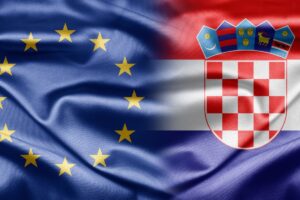In terms of contracts, Croatia holds 3rd place, and in terms of disbursed funds, we are 13th ranked in the EU.
We are still using the funds from the previous program period of 2014-2020, since the certification process follows the so-called N+3 dynamics defined by the European Commission, which means that these funds are used for another 3 years after the end of the financial perspective, says Šime Erlić, Minister for Regional Development and EU Funds, for Diplomacy&Commerce. He also explains that, in terms of encouraging investment, the funds for the new program period of 2021 – 2027 are mainly directed towards the green and digital transition, but also to numerous other areas.

- As the youngest EU member, Croatia relies significantly on EU funds. How successful was Croatia in implementing the program and how much of the planned funds did we use?
Objective indicators speak best about success. The European Commission Cohesion Data platform provides an overview of various data related to the use of EU funds at the level of the European Union. There are two key indicators by which we compare ourselves with other member states – the first is the contractual nature of funds, and the second is the level of disbursed funds. In terms of contracts, Croatia holds 3rd place, and in terms of disbursed funds, we are 13th ranked, so we are somewhere in the middle. It is evident that we are accelerating the absorption year after year, considering that in 2020 we were in 21st place. These are very good results, not only because they speak about how the funds are being used successfully, but they also show that the system we established for the use and control of EU funds is functional and effective. We are still using the funds from the previous program period of 2014-2020, since the certification process follows the so-called N+3 dynamics defined by the European Commission, which means that these funds are used for another 3 years after the end of the financial perspective. The system is currently slightly above 80% of disbursed funds in relation to the allocated funds. Our transitory time is good and we expect a very intense period until the end of this year. The projects need to be completed, and in this sense I expect the maximum engagement of all users, that is, finally, the absorption of 100% of the funds.
- The “New Opportunities” project has been expanded to several cities in Croatia. Which new opportunities would you single out? How are we progressing in the use of EU funds from this budget period?
In general terms, we can say that in terms of encouraging investment, the funds for the new program period of 2021 – 2027 are mainly directed towards the green and digital transition, but also to numerous other areas. In the years to come, the focus will certainly be on the energy transformation of the entire European economy, which will also follow the achievement of the defined climate goals. The green transition has no alternative and the only question is when it will be implemented, but it is important that we have already started in that direction. So to answer your question, I can say that it is about supporting investments in smart industry, encouraging the partnership of scientific and business sectors, further development of the broadband Internet network, investing in renewable energy sources. The announcement of calls divided by sector among different departments is in a final stage of readiness, and by the end of this year we expect the first calls and the allocation of funds for investments of the new program period. I also have to say that we will increase our focus on our goal of uniform regional development in all parts of Croatia in the coming period, so we will direct significant funds to raising the quality of life in assisted and mountainous areas.
In addition, considering the incredible wealth we have thanks to our indented coast, i.e. the islands that have enormous potential that we may not even be aware of at the moment (but we have to change that), we have secured additional funds specifically for the islands. Croatia is the only country of the European Union, along with Finland, which has a special Act on islands. We have earmarked an amount of 470 million euros from the new financial envelope for the support of assisted and mountainous areas, and 150 million euros for support to the islands. On top of all of the above, as not many members of the European Union, Croatia secured as much as 13% of cohesion policy funds for investments in urban development for its 22 cities. With this money, cities (county centers) will be given an instrument for the implementation of strategies for the development of urban areas, and the spectrum of acceptable investment has been expanded compared to the previous period and includes brownfield investments, investments in cultural heritage, energy efficiency, urban mobility, sustainable tourism, entrepreneurship, etc. It is a unique opportunity for cities to integrate their investments and realize the planned development vision.

- Which projects would you single out as the most important ones on a national level, although they are all important?
In recent years, many countries have achieved positive trends thanks to cohesion policy. Therefore, while approaching the end of the 2014-2020 program period, we too can testify to numerous achievements so far thanks to EU funds. Every corner of Croatia was touched by investments financed by European funds, which directly resulted in a better standard of our citizens. It is difficult to talk about the most important projects, because some smaller ones have significantly improved the quality of life. For example, a very valuable water and communal, road and port infrastructure was built, significant investments in renewable energy sources were carried out (over 1,000 projects in the housing sector alone), hospitals, campuses were improved, we got an improved system for deinstitutionalization of social care, as well as revitalized numerous objects cultural and natural heritage. Of course, the most visible and with the greatest scope of impact are large public infrastructure projects such as the Pelješac Bridge, but we should not forget that numerous Croatian companies have built their business success precisely on the withdrawal of EU funds, especially thanks to generous grants. I must also underline that our economy recovered extremely quickly after the COVID pandemic and the recent crises. Official European statistics show that this is so – Croatia is in the top 3 of the fastest growing economies of the European Union, with a 6.3% GDP growth last year, which is twice as much as the European Union, and I’m sure that the successful withdrawal of EU funds also contributed to this.
- Your Ministry pays great attention to cross-border cooperation, as well as to territorial (Interreg Central Europe) cooperation. Can you single out some of the projects and why they are important?
By implementing the cohesion policy, the idea is to maximally combine the advantages of each involved country in order to multiply the individual positive effects. Achieving good results knows no territorial boundaries, so individual countries strive to connect directly and encourage more intensive cooperation. This is what we want to continue to work on in the future, especially when it comes to cross-border cooperation with neighboring countries. There is a whole series of valuable projects on which Croatia has collaborated with other member countries, for example with Italy on the strategic project Firespill, which improves the operational capacity of emergency services, or with Slovenia on the Frisco project, where Croatian and Slovenian water management institutions and cooperating institutions of both countries effectively manage risks from floods. By pooling resources, exchanging knowledge and good practices, scientific cooperation is improved, infrastructure of common importance is built, people and experiences are connected, and ultimately the quality of life is raised, which is the main goal of using the Funds.
- Where do you see issues and fears regarding the implementation of the projects you have?
Croatia has a total of 25 billion euro at disposal from various EU funds by the end of this decade. This is a large amount, especially if it is put in relation to our GDP, but also to the default withdrawal periods. So, the funds have never been bigger and this is an exceptional opportunity for our economy and the improvement of all parts of our society and parts of Croatia, but it is also a great challenge for the capacities of our administration. The past period has shown that we work well, but of course, we monitor the processes and continuously improve them. People are the most important link, and we must permanently take care that key bodies, as well as local and regional self-government units that implement projects, are sufficiently and qualitatively capacitated, both in terms of organization and in terms of personnel. Only in this way will we withdraw all available funds and accelerate their absorption.
- Where and how do you see Croatia in 5 years, among other also thanks to EU funds and faster regional development?
The first full EU envelope that we consumed, the first complete financial perspective, is behind us. Thousands of projects have been implemented and investments have brought changes to every part of our country. The best indicator of how far Croatia has progressed in the last 10 years, since it became a member of the European Union, is our GDP. In 2013, it was at 61% of the European average, while in 2021 it rose to 70%, the same as GNP. It is estimated that GDP is 5% higher than it would be without the effects of cohesion policy, which means that there is a clear correlation between GDP growth and the use of ESI funds. Croatia has shown exceptional resilience and a high ability to quickly recover. I expect that in the next decade we will continue to grow and that we will get even closer to the standard of the most developed members of the European Union.